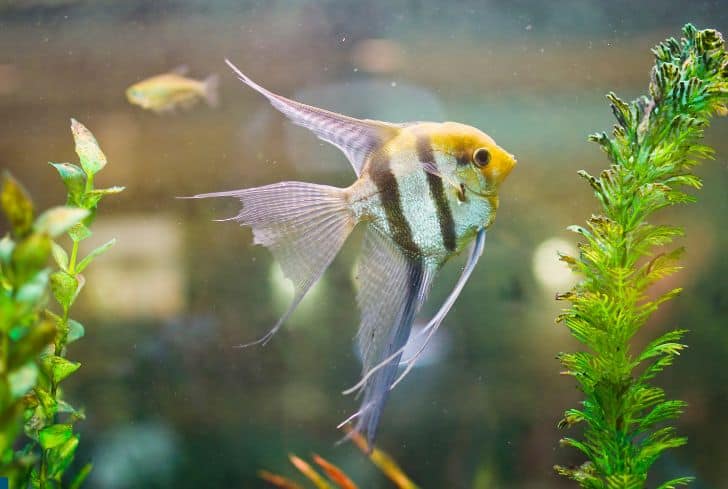15 Types of Fish With Big Foreheads (With Pictures)

Fish with big foreheads are among some of the world’s oddest creatures. Marine biologists are used to encountering these types of fish in their missions, but you can also see them, especially when scuba diving – You just need to be patient and squint enough and wait for your moment.
If you’re not a marine biologist or a scuba diver, this post is your chance to see (we’ve included images) these types of fish with big foreheads and also learn a few things about them (including some fun facts).
And if you’re a fish enthusiast, you’ll know the types you can add to your home aquarium.
Let’s dive in.
Read: 13 Types of fish with big teeth
13 Types of Fascinating Fish With Big Foreheads
1. Napoleon fish

Napoleon fish is an enormous species of wrasse that roams the coral reefs on the east coast of Africa, particularly Madagascar and some regions of the Pacific ocean. Its color falls in between green-blue and purplish-blue.
Napoleon fish has a massive protruding forehead which, plus the two black lines just behind the eye and thick lips, help make the fish easier to recognize. The distinctive gigantic forehead is the root of the fish’s name as it mimics Napoleon Bonaparte’s hat. The forehead continues to grow as the fish gets older.
If you want to keep napoleon fish in your aquarium, the fish is docile, making it an excellent addition. You can feed it clams, crabs, and snails, but ensure you follow Napoleon fish aquarium tips for best results.
However, the fish is considered endangered by the IUCN Red list due to several factors, including local consumption, degradation, and habitat loss.
Fun fact; napoleon fish is intersex, meaning it can change gender!
2. Beluga whales

Beluga whales are highly social sea mammals that live in groups of about 10 – 100 individuals. These whales are found worldwide, inhabiting arctic and sub-arctic waters. They are highly adaptable creatures that live in both saltwater and freshwater environments.
Beluga whales are stocky, and their sizes fall between a true whale and a dolphin.
While the most distinguishing feature of the beluga whales is their white or whitish-grey color, the mammals also have a distinctive forehead that houses an organ called a melon. The melon contains fatty tissues making it malleable, allowing the animals to make facial expressions and various sounds, including whistles, chirps, and squeals.
3. Midas cichlid
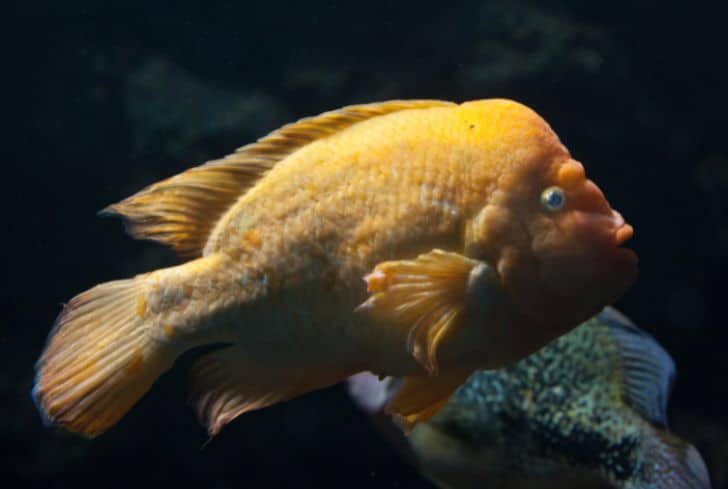
Midas cichlid is a large, heavily built cichlid fish that hails from Costa Rica and the San Juan River. This beauty has an oval body and is born greyish, but that color changes as the fish ages.
Midas cichlid is a unique fish among the fish with big foreheads. As the fish mature, the males develop a big nuchal hump on their foreheads while the females just a hint of it. According to Research Gate, this nuchal hump may function as a sex or species recognition trait. Interestingly, in wild Midas cichlids, the hump appears only during the breeding season, unlike in aquarium species, where it stays permanently.
Because of their color and unique characteristics, Midas cichlids are common in many aquariums. The fish are omnivores – so they welcome various aquarium foods such as vegetables and free-dried foods. However, they are aggressive and territorial, so you can’t keep them in a community tank. Midas Cichlids Fish Profile is a rich resource if you wish to raise this fish species.
4. Green Humphead parrotfish
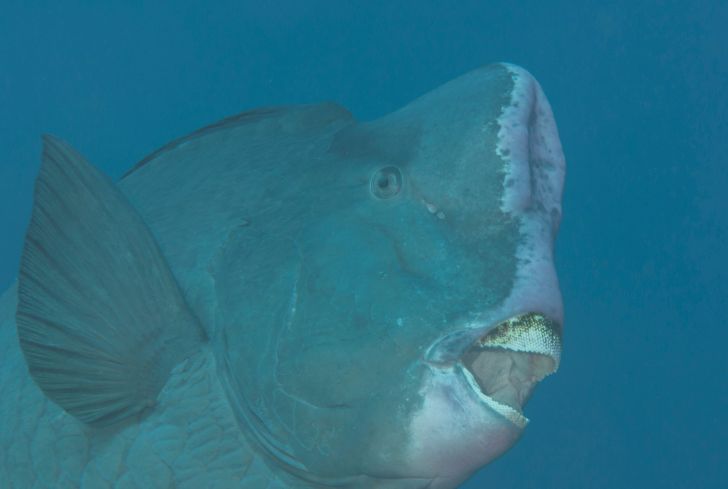
Green Humphead parrotfish live in reefs of the Pacific and Indian Oceans. They have a unique mouth that resembles a parrot’s bill.
Green humphead parrotfish have massive foreheads and an enormous hump that serves multiple functions. The fish use the hump to break off pieces of coral for easy digestion, and it has even adapted to crush even hard coral. This adaptation comes in handy as they can eat coral while no other animal can, reducing food competition to zero. Furthermore, the fish use the hump for defense, as they can headbutt other fish when mating or competing for food.
The perfect body shapes and beautiful coloration of these tropical fish are enough to tempt you to keep them in your aquarium. However, it’s not advisable as green humphead parrotfish do not adapt well to captivity life. If you want to see them, they’re a common sight if you scuba dive near their native waters.
However, the green humphead parrotfish is now a vulnerable species on the IUCN Red list as its wild numbers are decreasing mainly due to overfishing and habitat loss.
5. Dolphinfish

Dolphinfish, also called mahi-mahi, is a saltwater fish and one of the fast swimmers as it can reach speeds of about 60 miles per hour. It might share a name with the marine mammal dolphins, but the two animals are not related. The fish prefers subtropical and tropical waters worldwide.
The brightly colored dolphinfish possess unique features that make them distinguishable from other types of fish. They have prominent foreheads, blunt faces, forked-tail fins, and prominent faces.
There’s little research on the functions of the forehead in dolphinfish, and the available information suggests this feature helps to distinguish between males and females. While male dolphinfish have protruding foreheads, their female counterparts have rounded ones.
The fish is one most beautiful in the sea, which gives you a hint why it’s highly prized commercially and also as a gamefish. It’s also a common aquarium fish.
6. Kamfa
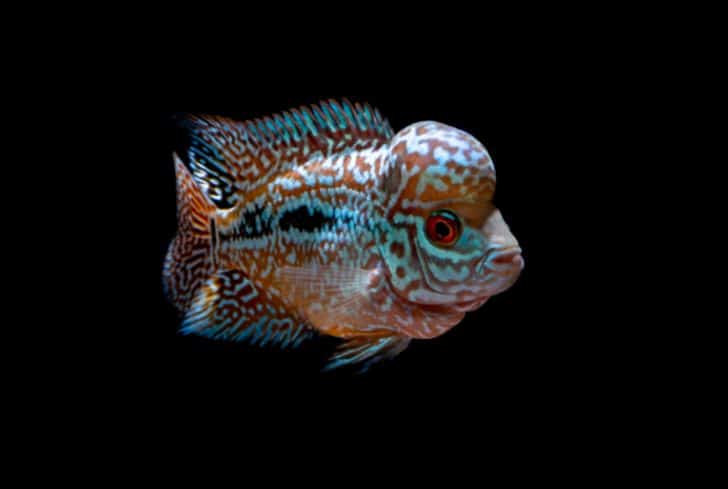
Kamfa is a magnificent, ornamental fish you can never find in natural waters as it is a result of crossing any species of Vieja with different species of parrot cichlid. That’s why it doesn’t have a scientific name.
Kamfa is not only characterized by its square-shaped body. But also by its prominent forehead that carries a lump called a nuchal hump. The hump is composed of soft tissue to store fat and give the fish extra energy during the breeding season. Like in a cichlid, the hump might be the distinguishing feature between males and females. Other theories claim the hump is for attractive purposes, with the male with the prominent forehead being more desirable to females.
Fish enthusiasts love this artificial fish not only because it’s colorful but also because it’s one of the few you can interact with. This Kamfa ultimate guide will guide you through if you wish to acquire one.
Fun fact; kamfa fish change colors throughout their lives.
7. Humphead glassfish
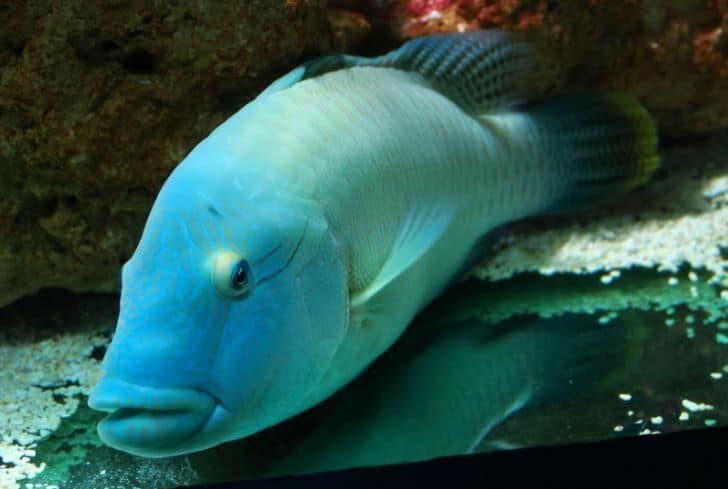
The Humphead glassfish is a saltwater fish that inhabit the large and fast-flowing rivers of Thailand and Myanmar.
Like all species of glassfish, the humphead has a semi-transparent body. But the most remarkable feature distinguishing it from other members is the massive forehead that carries a nuchal hump. Males are easily recognized as this feature is more prominent in them than it is in females. The purpose of this hump is not understood, but as research suggests on other types of fish with these features, the function might be the same.
The good news to fish enthusiasts is that humphead glassfish are less demanding, so you can keep them in your aquarium without needing attention.
8. Oranda
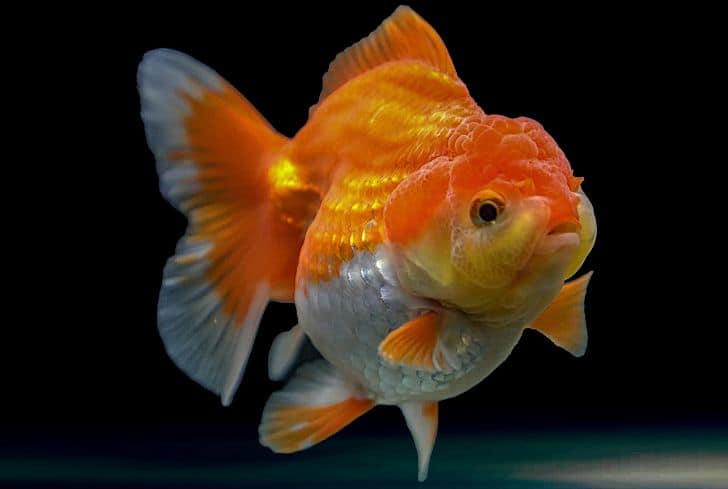
A breed of goldfish, oranda is another type of fish that doesn’t occur in natural waters but is widely distributed in ponds and aquariums.
While oranda has a tall tail fin, the most distinctive feature is the forehead that looks like a bubble-like hood called wen or crown. While the wen lies on top of the head, it grows to cover the entire face (and limit the fish’s eyesight or render it blind, leaving only the mouth. The raspberry-shaped wen starts growing when the fish reach about four months until they’re around four years old.
Orandas are among the most friendly fish, which is why they’re common in many aquariums worldwide. They’re a joy to watch, thanks to their shimmering metallic scales, which come in various colors, including chocolate, red, black, and blue.
9. Lionhead cichlids
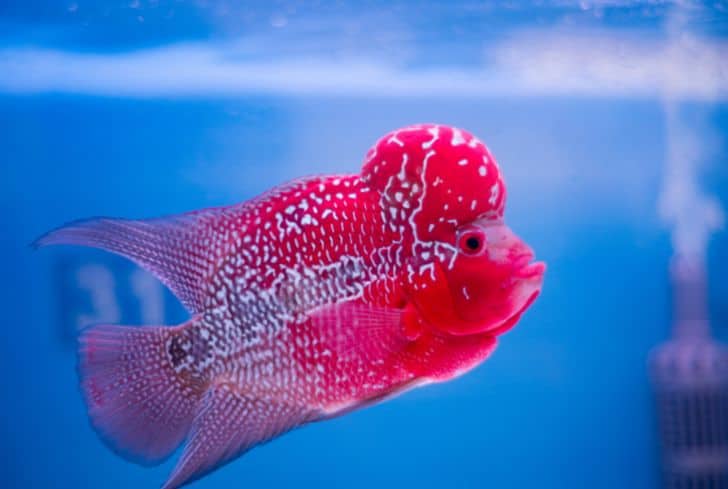
Also known as African blockheads, humped cichlids, and buffalo heads, the lionhead is a rheophilic cichlid predominant in the lower Congo River in the republic of Congo and DRC.
All lionhead cichlids have elongated snouts, but males have distinctive large foreheads with nuchal humps to separate them from females. Like in oranda and humphead glassfish, the nuchal humps in these cichlids grow as the fish age. Little is known about the purpose of the nuchal humps in the African blockheads, but going by the narrative, it plays the same roles as in oranda.
Instead of going to the native waters to see these fish, you can visit local fish aquariums, as the cichlids are common since they are easy to care for.
10. Front cichlids

Front Cichlids are East African fish species that live in Lake Tanganyika in Tanzania. They deservedly earn their species name frontosa thanks to their big foreheads.
All front cichlids are identical, with their blue or white body spiced with marks of about seven vertical bars. That makes it hard to differentiate between a male and a female front cichlid until the fish are about three years old. That is when a nuchal hump starts growing on the upper side of the male’s forehead.
These fish have a long life span, with some reaching about 25 years. They’re favorites with aquarium lobbyists as the fish are hardy and easy to care for.
11. Hump-headed blenny

Hump-headed blenny, known by many names, including bullethead rockskipper, and Blenniella gibbifrons, are combtooth fish native to coral reefs of the Indian and Pacific Oceans. Its range spans East Africa to Hawaii to Marcus Island.
Hump-headed blenny is one rare species because it’s one of the most unknown fish in the world. It spots a prominent forehead whose purpose is undocumented.
The fish may not be colorful but do not grow big hence are an ideal option for home aquariums. They can peacefully co-exist with other fish species, but surprisingly, they get aggressive when you bring in their kinds.
12. Sperm Whales
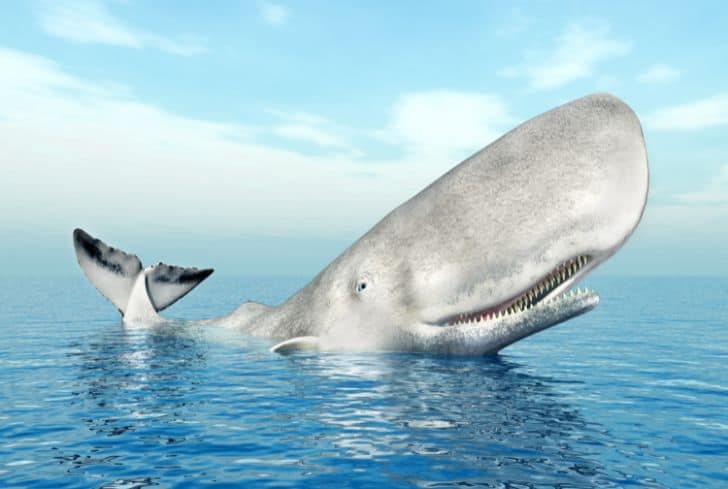
Sperm Whales are the largest toothed predators, and their ranges span worldwide. They migrate seasonally for breeding and feeding purposes.
These giant whales are characterized by their massive heads, which make up at least a third of the animal’s body mass. So as you would expect, no fish can match sperm forehead, even when you compare relatively. Inside the enormous forehead lies two oil-filled sacs called spermaceti organs. According to the dailymail, scientists suggest male sperm whales use their big foreheads to ram love rivals and small ships.
13. Flowerhorn fish
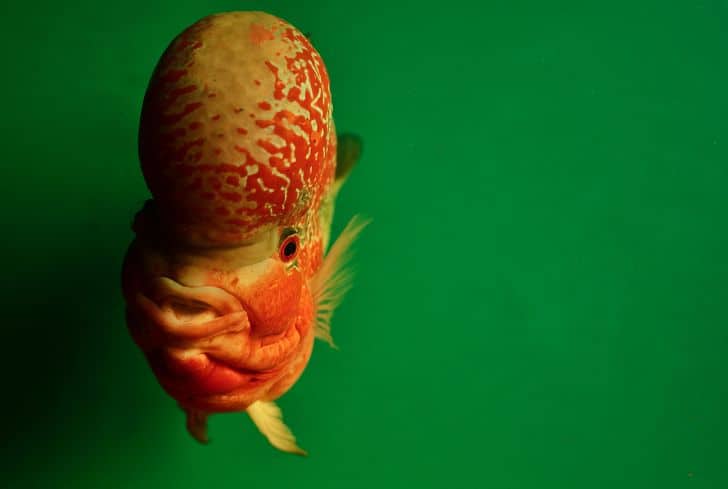
Like Kamfa, flowerhorn are ornamental fish commonly found in many aquariums due to their bright colors and heads with distinct shapes. You can only find these fish in aquariums or ponds, as they are artificial, having been developed in Malaysia, Taiwan, and Thailand,
While flowerhorn are known for their vivid colors, they also have bulbous heads with nuchal humps called Kok on the top. Both males and females have this distinctive look, although it’s prominent in the former.
14. Barreleye fish
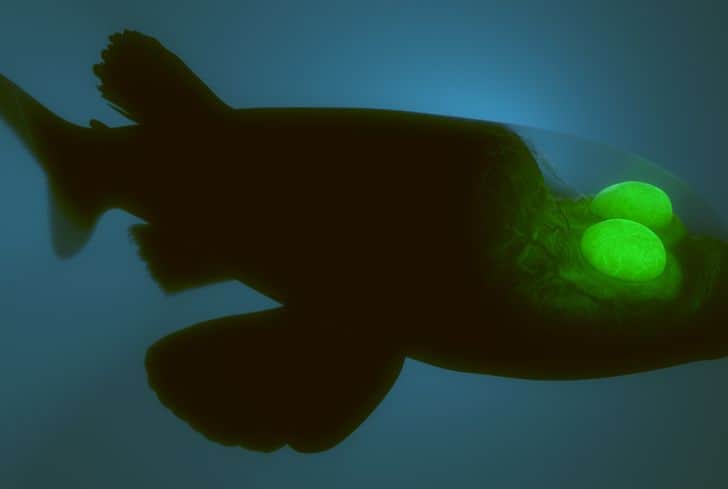
Barreleyes are small, hard-to-find fish from the Opisthoproctidae family. They’re native to temperate and tropical waters of the Pacific, Atlantic, and Indian oceans.
Barreleye fish are unique with their large transparent foreheads that look like a canopy above the eyes. According to researchers, this forehead helps protect the eyes as the fish steal food from other competitors in the sea. The canopy-like head also allows the eyes to collect sufficient light to facilitate its navigation missions.
15. Bowhead Whale
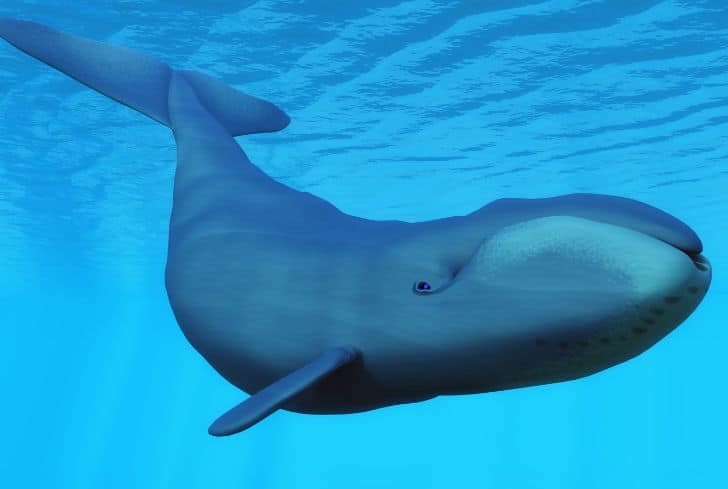
Bowhead Whales are a species of baleen from the Balaenidae family. They are one of the world’s oldest mammals and are only endemic to arctic and sub-arctic waters.
Growing up to about 66 feet, the bowhead Whales have massive heads, so it’s not surprising that they also boast large foreheads. According to the Endangered Species Coalition, the forehead is so enormous that the whale uses it to “smash through up to two feet of ice” when taking a breath!




